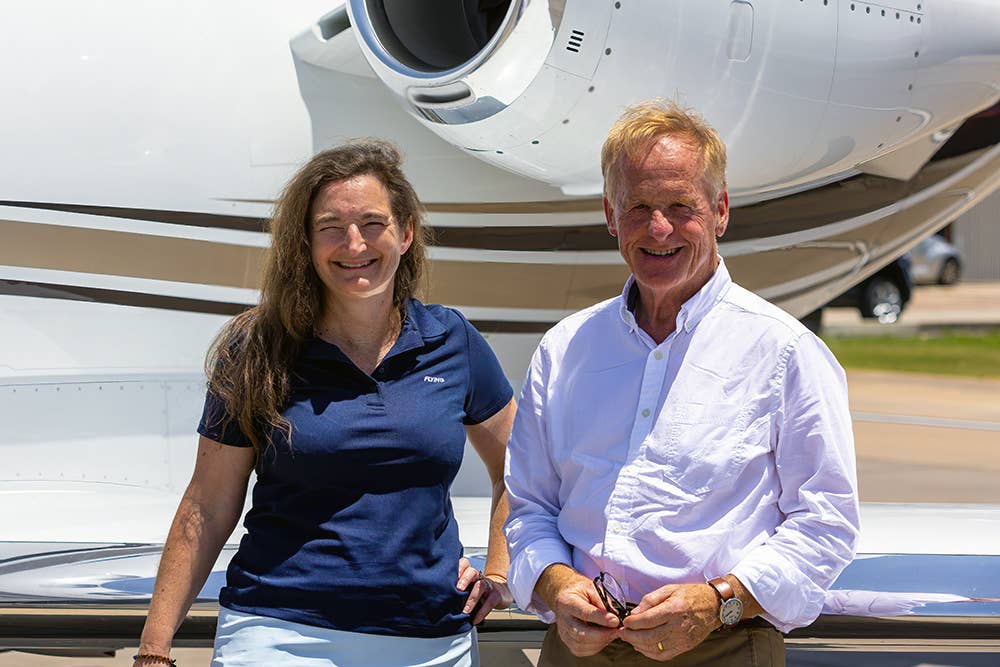Taking Off on a Dove Flight to Disney
The 2022 Special Olympics Airlift coordinated by Textron Aviation and jet owners and pilots successfully brings athletes home from the games.

The 2022 Special Olympics Airlift coordinated by Textron Aviation and jet owners and pilots successfully brings athletes home from the games. [Photo: Stephen Yeates]
“Dove 135, you’re cleared to the Orlando Executive airport, via ILEXY3 ZENZI then as filed. Climb and maintain 3 thousand, then expect flight level 310 10 minutes after departure. Departure frequency is 119.0, squawk 2527.”
With that we were ready to taxi out as the dawn broke at the San Marcos Municipal airport in Texas, ready to head to KORL to fetch our “customers” for the day. The rest of our clearance read “CEW CABLO BIGDE” then the SHREK2 arrival. The folks we’d pick up at Orlando Exec (KORL) had spent the past week at Disney—but not for a fun time shuttling through the parks, but at the ESPN Wide World of Sports Complex at the Walt Disney World Resort.
They’d just competed in the 2022 Special Olympics USA Games. And we were flying in as one of 128 “Doves” volunteering to help bring them home.
An Early Start
In order to orchestrate the arrival and departure of nearly 150 Cessna Citations, Beechcraft King Airs, Premiers, and Beechjets, and Hawkers, Textron Aviation had sent out a briefing to the pilots who would crew the donated owner-flown and corporate turbine aircraft. I’d read through it after it was forwarded to me by Jerry Gregoire, owner of the Citation M2—and it looked very similar to those plans I’d seen prior to earlier SOA missions I’d been part of in 2006 and 2010.
Though the M2 is a single-pilot-operated jet—and Gregoire has been flying the 525 series for more than 12 years—SOA procedures require two pilots on board the designated “Dove” flights. And it’s a good idea. Because although the flight plans in and out of the busy metro areas such as Orlando come to us preplanned, things happen quickly once we’ve landed and get sequenced into the SOA ramp at KORL.
We spent the two and a half hours en route catching up and observing the cells building over the Gulf of Mexico—as we took a northern (land) route for our trip into Florida. Those cells would determine our flight plan back to Texas, into Houston Hobby airport (KHOU), where we would drop off our precious cargo before returning to San Marcos (KHYI). A string of MOAs (military operations areas) line the coastal waters and make it challenging to deviate for weather once off shore. While the offshore route saved us about 15 minutes of cruise, it was already looking like we’d be taking the land route back.
Ground Ops at KORL
After landing on Runway 25 at KORL, we taxied into the arrival chutes preplanned by Textron Aviation’s operations team. We had the green fuel placard in the window, and Gregoire handed the fuel order to the volunteer who greeted us. From that point, at about 10 a.m. local time, to our departure from the chocks around 11:20 a.m., we were busy getting recharged in the pilot center tent—both bio breaks and pilot snacks—and filing our flight plan back out.
We also had a chance to meet the athletes we’d take back—in the departure hangar, those four faces became more than what was handed to us on the manifest. Tyrell Coats and Joseph Nakamura played on the basketball teams, and Nakamura had a gold medal to show for his efforts. Samuel Schuster competed in powerlifting—and he proudly confirmed his ultimate lift of 308 pounds. A successful event as far as the scoreboard was concerned—but also so much to take away in terms of life experience, for all of us.
Across the board, volunteers to the SOA report that they participate year after year because the reward so far outweighs the time and resources spent. That’s true of Textron volunteers, and even more so of the pilots and owners who fly the missions. “It’s just the right thing to do,” as Gregoire mentioned during our time flying back. “It shows the best side of general aviation.”
The Trip Home
We greeted the team at the airplane, and took the requisite photos for posterity. Once the door was opened, the three athletes and their partner, Jacob Ray, climbed on to the M2 and settled quickly into their seats. It had been a while since I’d given a preflight passenger briefing, but our pax was excited and ready to go home.
We’d filed the course to take us back up the Florida panhandle and across Alabama, Mississippi, Louisiana, and on into Houston, and before we knew it we were instructed to “line up and wait” on Runway 25 to bust out of town. With a stroke of the ATC pen we cut the corner and gained a bit of time going direct to JAWJA and then another cut straight to DEFUN, then on course via CEW (Crestview VOR), J50, and AEX (Alexandria VOR) and the WAPPL6 arrival into Houston.
After a bit of a fistfight with the gusty afternoon winds—it was pushing 103 degrees F on the ground—Gregoire made a smooth touchdown on Runway 22 at Hobby, and we taxied into Signature. We said goodbye to our new friends, who let us know that the M2 was definitely their preferred way to travel.
Next time—2026?—you bet, guys!

Subscribe to Our Newsletter
Get the latest FLYING stories delivered directly to your inbox






